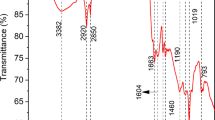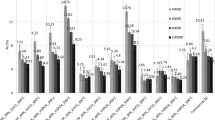Abstract
Removal of oil spillage from the environment is a global concern. Various methods, including the use of fibers as sorbents, have been developed for oil spill control. Oil palm empty fruit bunch (OPEFB) fiber is a plant biomass that may be acetylated by acetic anhydride using N-bromosuccinimide (NBS) as a catalyst; here, the extent of acetylation may be calculated in terms of weight percent gain (WPG). The modified fiber was used to remove Tapis and Arabian crude oils. The optimum time, temperature, and catalyst concentration were 4 h, 120 °C, and 3 %, respectively, and these parameters could achieve an 11.49 % increase in WPG. The optimized parameters improved the adsorption capacity of OPEFB fibers for crude oil removal. The acetylated OPEFB fibers were characterized by using Fourier transform infrared spectroscopy and field emission scanning electron microscopy to observe the functional groups available and morphology. Kinetic and isotherm studies were conducted using different contact times and oil/water ratios. The rate of oil sorption onto the OPEFB fibers can be adequately described by the pseudo-second-order equation. Adsorption studies revealed that adsorption of crude oil on treated OPEFB fiber could be best described by the Langmuir isotherm model.








Similar content being viewed by others
References
Adebajo MO, Frost RL, Kloprogge JT, Carmody O, Kokot S (2003) Porous materials for oil spill cleanup: a review of synthesis and absorbing properties. J Porous Mater 10:159–170
Angelova D, Uzunov I, Uzunova S, Gigova A, Minchev L (2011) Kinetics of oil and oil products adsorption by carbonized rice husks. Chem Eng J 172:306–311
Annunciado T, Sydenstricker T, Amico S, Annunciado T, Sydenstricker T, Amico S (2005) Experimental investigation of various vegetable fibers as sorbent materials for oil spills. Mar Pollut Bull 50:1340–1346
Asadpour R, Sapari NB, Tuan ZZ, Jusoh H, Riahi A, Orji KU (2013) Application of sorbent materials in oil spill management: a review Caspian. J Appl Sci Res 2:46–57
Asadpour R, Sapari NB, Isa MH, Orji KU (2014a) Enhancing hydrophobicity of mangrove bark by esterification for oil adsorption. Water Sci Technol 70:1220–1228. doi:10.2166/wst.2014.355
Asadpour R, Sapari NB, Isa MH, Orji KU (2014b) Investigation of modified mangrove bark on the sorption of oil in water. Appl Mech Mater 567:74–79
Asadpour R, Sapari NB, Isa MH, Kakooei S, Orji KU (2015) Acetylation of corn silk and its application for oil sorption. Fibers Polym 16:1830–1835. doi:10.1007/s12221-015-4745-8
Asadpour R, Sapari NB, Isa MH, Kakooei S, Orji KU, Daneshfozoun S (2016) Esterification of corn silk fiber to improve oil absorbency. Adv Mater Res 1133:552–556
Barnette AL et al (2012) Quantification of crystalline cellulose in lignocellulosic biomass using sum frequency generation (SFG) vibration spectroscopy and comparison with other analytical methods. Carbohydr Polym 89:802–809
Bastani D, Safekordi A, Alihosseini A, Taghikhani V (2006) Study of oil sorption by expanded perlite at 298.15 K. Sep Purif Technol 52:295–300
Boopathy R (2000) Factors limiting bioremediation technologies. Bioresour Technol 74:63–67
Carmody O, Frost R, Xi Y, Kokot S (2007) Adsorption of hydrocarbons on organo-clays—implications for oil spill remediation. J Colloid Interface Sci 305:17–24
Choi HM, Moreau JP (1993) Oil sorption behavior of various sorbents studied by sorption capacity measurement and environmental scanning electron microscopy. Microsc Res Tech 25:447–455
Eric H, Chongrak K, Noureddine A, Jean P (1998) Application of methylene blue adsorption to cotton fiber specific surface area measurement. J Cotton Sci 2:164–173
Ghazali A, Wan Rosli W, Law K (2009) Pre-treatment of oil palm biomass for alkaline peroxide pulping. Cellul Chem Technol 43:331–338
Hamzah F, Idris A, Shuan TK (2011) Preliminary study on enzymatic hydrolysis of treated oil palm (Elaeis) empty fruit bunches fibre (EFB) by using combination of cellulase and β 1–4 glucosidase. Biomass Bioenergy 35:1055–1059
Isa MH, Ibrahim N, Aziz HA, Adlan MN, Sabiani NHM, Zinatizadeh AAL, Kutty SRM (2008) Removal of chromium (VI) from aqueous solution using treated oil palm fibre. J Hazard Mater 152:662–668
Karimi B, Seradj H (2001) N-bromosuccinimide (NBS), a novel and highly effective catalyst for acetylation of alcohols under mild reaction conditions. Synlett 4:519–520
RAHMAH AU (2009) Characterization of physicochemical properties and process design for oil removal using Ceiba pentandra (L.) Gaertn. as a natural sorbent. Dissertation, Universiti Teknologi Petronas
Rouquerol J et al (1994) Recommendations for the characterization of porous solids (Technical report). Pure Appl Chem 66:1739–1758
Salarirad MM, Behnamfard A Modeling of equilibrium data for free cyanide adsorption onto activated carbon by linear and non-linear regression methods. In: International Conference on Environment and Industrial Innovation, Singapour, 2011. IACSIT Press.
Shuit SH, Tan KT, Lee KT, Kamaruddin A (2009) Oil palm biomass as a sustainable energy source: a Malaysian case study. Energy 34:1225–1235
Sidik S, Jalil A, Triwahyono S, Adam S, Satar M, Hameed B (2012) Modified oil palm leaves adsorbent with enhanced hydrophobicity for crude oil removal. Chem Eng J 203:9–18
Stang M, Karbstein H, Schubert H (1994) Adsorption kinetics of emulsifiers at oil–water interfaces and their effect on mechanical emulsification. Chem Eng Process Process Intensif 33:307–311
Sun X-F, Sun R, Sun J-X (2002) Acetylation of rice straw with or without catalysts and its characterization as a natural sorbent in oil spill cleanup. J Agric Food Chem 50:6428–6433
Sun X, Sun R, Sun J (2004) Acetylation of sugarcane bagasse using NBS as a catalyst under mild reaction conditions for the production of oil sorption-active materials. Bioresour Technol 95:343–350
Teli M, Valia SP (2013a) Acetylation of banana fibre to improve oil absorbency. Carbohydr Polym 92:328–333
Teli M, Valia SP (2013b) Acetylation of jute fiber to improve oil absorbency. Fibers Polym 14:915–919
Toyoda M, Inagaki M (2003) Sorption and recovery of heavy oils by using exfoliated graphite. Spill Sci Technol Bull 8:467–474
Tryba B, Morawski AW, Kalenczuk RJ, Inagaki M (2003) Exfoliated graphite as a new sorbent for removal of engine oils from wastewater. Spill Sci Technol Bull 8:569–571
Wang J, Wang A (2013) Acetylated modification of kapok fiber and application for oil absorption. Fibers Polym 14:1834–1840
Zahed MA, Aziz HA, Isa MH, Mohajeri L, Mohajeri S (2010) Optimal conditions for bioremediation of oily seawater. Bioresour Technol 101:9455–9460
Acknowledgments
The authors would like to thank Universiti Teknologi PETRONAS for providing the facilities and funding through the University Internal Research Funding (URIF Grant No 0153AA-B18) and Ministry of Higher Education (FRGS Grant No 0153AB-I09) for the financial support.
Author information
Authors and Affiliations
Corresponding author
Additional information
Responsible editor: Santiago V. Luis
Rights and permissions
About this article
Cite this article
Asadpour, R., Sapari, N.B., Isa, M.H. et al. Acetylation of oil palm empty fruit bunch fiber as an adsorbent for removal of crude oil. Environ Sci Pollut Res 23, 11740–11750 (2016). https://doi.org/10.1007/s11356-016-6349-2
Received:
Accepted:
Published:
Issue Date:
DOI: https://doi.org/10.1007/s11356-016-6349-2




